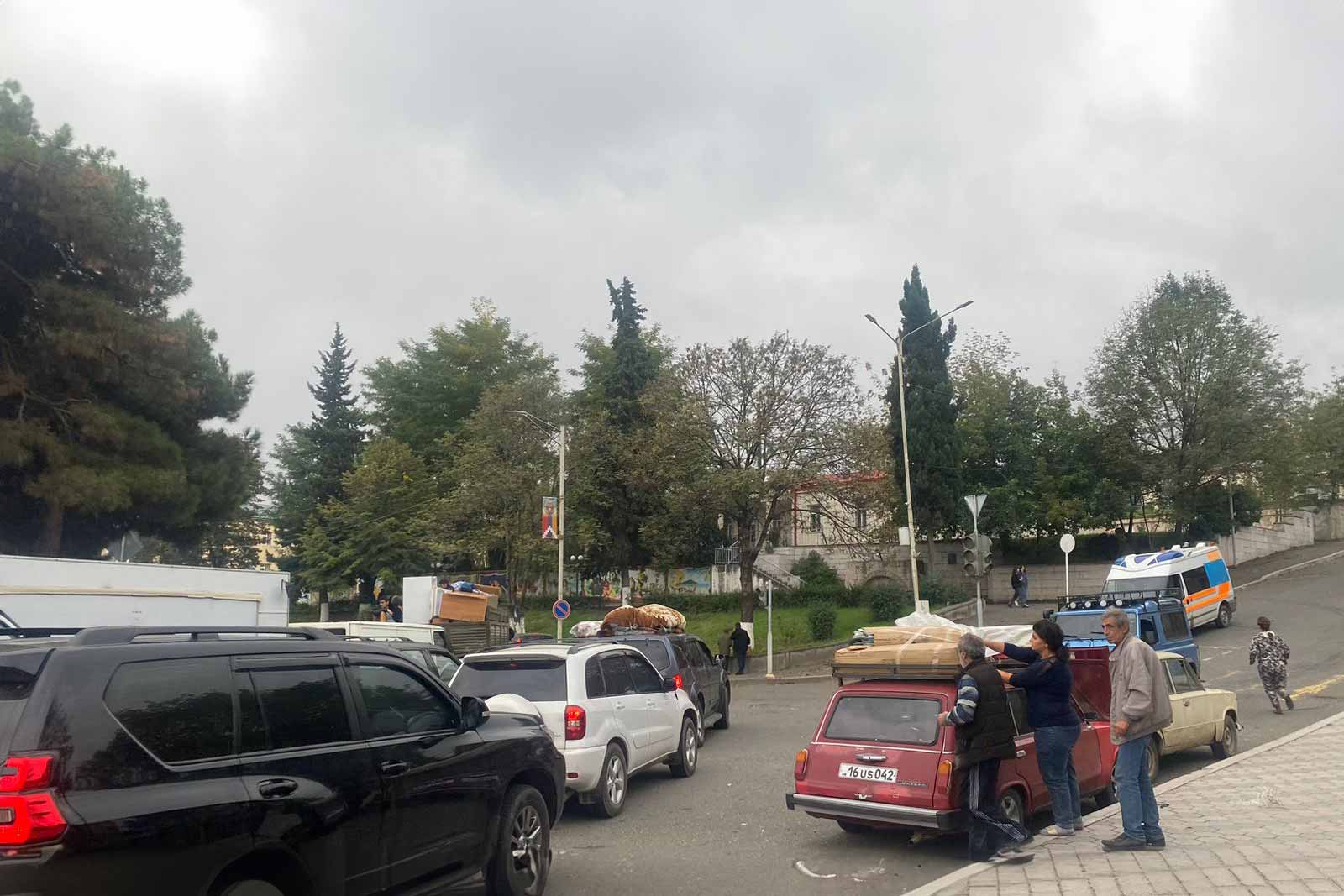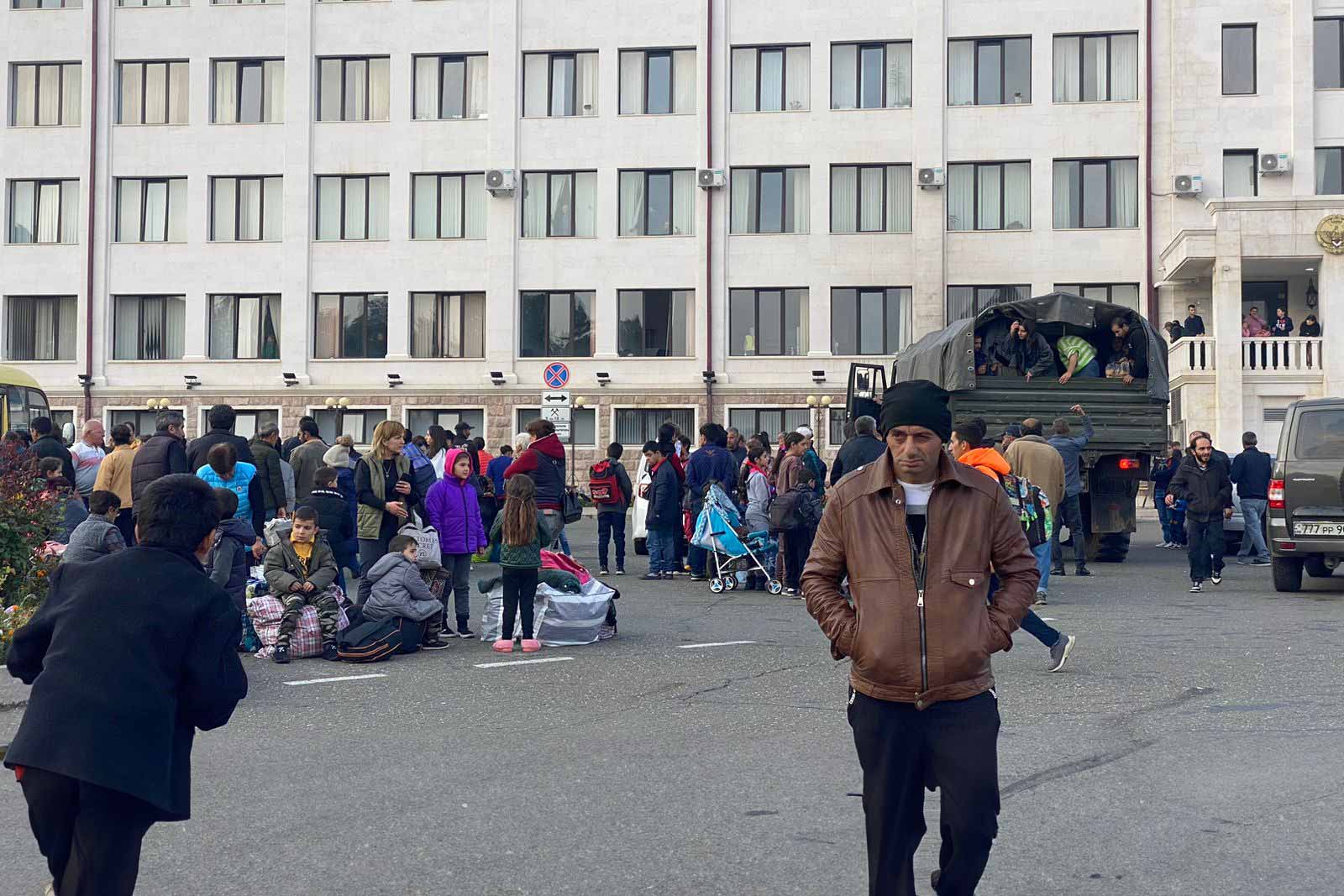Nagorny Karabakh’s Uncertain Future
Despite Baku’s messages of reassurance, many locals fear campaign of ethnic cleansing.
With thousands fleeing Nagorny Karabakh after Azerbaijan’s lightning victory ended 30 years of de facto sovereignty by a breakaway Armenian community, its population faces an uncertain future.
As Azerbaijanis celebrate a future homecoming to the long-estranged region, scores of buses and cars carrying Karabakh residents headed to neighbouring Armenia. The authorities said they were prepared to accommodate 40,000 people, a third of Karabakh’s estimated population.
“My family, like most of other families, is planning to leave,” said a teacher from Stepanakert, the de-facto capital that Azerbaijan calls Khankendi. Speaking to IWPR over Telegram, she asked not to be identified by name as she feared for her and her family’s safety.
“Some people, especially the elderly, won’t be able to leave, because they lived here their entire lives and also being a refugee is a hard thing,” she wrote, adding that unless locals get safe passage to the Armenia, “we will all end up dead or become victims of violence”.
"The key is ensuring that local Armenians feel safe and free to consider their options.”
To pacify fears of imminent ethnic cleansing, Azerbaijan vowed to protect the Armenians of Karabakh and integrate them in the Azerbaijani state as equal citizens.
“Karabakh Armenians must understand that by becoming part of the Azerbaijani society, they will receive security guarantees and will enjoy all the rights, including rights to religion, education and culture,” said Azerbaijan’s President Ilham Aliyev. “They will live a normal life.”
But Karabakh Armenians are not taking their chances. The moment Azerbaijan opened the Lachin corridor, the route connecting Karabakh to Armenia, residents began flooding out. Nearly 3,000 people had arrived in Armenia by Monday.
The fear of revenge is strong after decades of conflict and mistrust.

“There are whole generations on both sides that hate each other,” said Jenny Paturyan, associate professor of social and political sciences at the Yerevan-based American University of Armenia. “There will be constant tension. What is the guarantee that some crazy dude won’t try to become another national hero like Ramil Safarov?” she continued, in a reference to an Azerbaijani officer who murdered an Armenian serviceman in Budapest in 2004 and subsequently received a hero’s welcome in Azerbaijan.
Others argue that Aliyev was sincere meant about guaranteeing safety to Karabakh Armenians, not least because of reputational reasons.
“The mass exodus of ethnic Armenians to Armenian – whether voluntary or not – will be perceived by some international community as ethnic cleansing. There is a consensus in Baku against such a scenario,” said Zaur Shiriyev, Baku-based South Caucasus analyst with the International Crisis Group.
He noted Azerbaijani steps toward reassuring the Armenians, such as offering amnesty to those who laid down their arms and allowing international aid into Karabakh alongside some of its own.
Shiriyev argued that reconciliation and coexistence between Azerbaijanis and Karabakh Armenians could be achieved as long as Baku established its authority over the region in a measured and delicate manner.
“If Baku demonstrates goodwill and treats it a structured process, complemented by a transitional phase, integration and preservation of rights can be achievable,” he said. “The key is ensuring that local Armenians feel safe and free to consider their options.”
He added that rights to return and rights to their property must be guaranteed to those choosing to leave.
The view from Yerevan and Stepanakert was far more sceptical. Paturyan suggested that Baku’s security assurances were only superficial.
“There is a hope that they won’t be hugely mistreated for the time being because all eyes are on them,” she continued. “But they will be constantly harassed in small and seemingly unsystematic ways. […] You don’t have to openly mistreat people to make them feel unsafe. You can keep stealing their livestock or painting graffiti on their walls at night, and then blame it on some hooligans.”
The teacher from Stepanakert made a similar point, fearing that the moment international attention was diverted away from Karabakh, Azerbaijani forces would start tormenting and harassing Armenians, forcing them to leave, she said.
“They won’t stop until there are no Armenians left here,” she concluded.
“Stay or go is not a sustainable policy.”
However, the most unexpected source of reassurance came from Yerevan and Prime Minister Nikol Pashinyan. After months of warning the world of imminent ethnic cleansing in Karabakh, he announced via Facebook live on September 21 that “there is no direct threat to the civilian population of Nagorny Karabakh” and told Karabakh Armenians to stay put.
“Those promises ring hollow after 30 years of conflict and lack of any confidence-building measures or talks between the Nagorny Karabakh Armenians and Azerbaijani authorities,” Giorgi Gogia, associate director for Europe and Central Asia at Human Rights Watch, told IWPR.
Gogia pointed to Azerbaijan’s ten-month effective blockade of Karabakh, which caused dire food and fuel shortages – followed by the attack launched on September 19 - as contradictory evidence to Baku’s avowed peaceful intentions.
He also noted that Aliyev, Azerbaijan’s unchanged leader for 20 years, had brutally supressed all homegrown challenges including the few domestic voice who have criticised the use of force to resolve the Karabakh conflict.
“As Baku makes promises of respecting fundamental rights of the Armenian population, it arrested five people in Azerbaijan for what appears to be anti-war post in the social media,” Gogia said. “All of the above feeds the deep-rooted mistrust and fear among the local residents, making it hard to take to Azerbaijani promises at face value.”
Newly independent Azerbaijan and Armenia, both of whom view Karabakh as being of significant cultural and historic importance fought a full-blown war over the region following the fall of the Soviet Union. The first conflict, which ended in 1994, resulted in the expulsion of the Azerbaijani population from Karabakh and surrounding areas under Armenian control.
Karabakh, which called itself the Republic of Artsakh, maintained de-facto independence but effectively operated as Armenia’s dependency. The international community has consistently treated the region as legally part of Azerbaijan.
By the time of the second war in 2020, oil and gas wealth had allowed Baku to build up significant military superiority. Azerbaijan routed Armenian forces, reclaimed Armenian-occupied lands and encircled Karabakh. Yerevan rolled back its military support for Karabakh and recognised the territorial integrity of Azerbaijan.
Nonetheless, Baku accused Yerevan of continuing to provide military support to Karabakh and cut the region’s connection to Armenia. The military onslaught of September 19 forced the separatist government to agree to capitulation talks.

“The clear lessons learned from both the war for Karabakh in 2020 and the recent attack are the same: the temptation to rely on force over diplomacy,” said Richard Giragosian, director of the Yerevan-based Regional Studies Centre think-tank. “This was revealed by the absence of deterrence, whereby Azerbaijan faced little challenge and even less cost to its military aggression.”
In Azerbaijan, the mood has been celebratory since September 19, with many arguing that Karabakh’s Armenians should simply take Azerbaijani citizenship or leave.
Shiriyev warned against such a simplistic attitude.
“Stay or go is not a sustainable policy,” he said, adding that such approach might perpetuate the cycle of conflict and obstruct efforts to achieve lasting peace.
In the meantime, Armenians are angry with the world for doing little to contain Azerbaijan, with particular frustration directed at the region’s main powerbroker, Russia, which failed Armenia as an ally, protector and peacekeeper.
The West also gets its share of Armenian criticism. Some believe that the EU’s reaction was limited because it ultimately prioritised continental energy security.
Paturyan concluded, “Next time my European friends turn on gas in their European homes, they should think whose blood was spilled and whose dreams of freedom were crushed as a payment for that gas.”
This publication was prepared under the "Amplify, Verify, Engage (AVE) Project" implemented with the financial support of the Ministry of Foreign Affairs, Norway.
